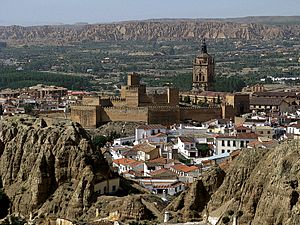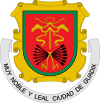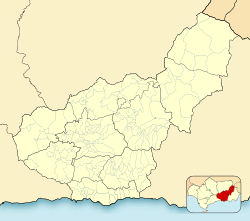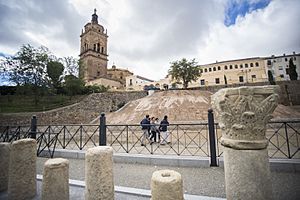Guadix facts for kids
Quick facts for kids
Guadix
|
|||
|---|---|---|---|
 |
|||
|
|||
| Country | |||
| Province | |||
| Judicial district | Guadix | ||
| Comarca | Guadix | ||
| Area | |||
| • Total | 317 km2 (122 sq mi) | ||
| Elevation | 913 m (2,995 ft) | ||
| Population
(2018)
|
|||
| • Total | 18,718 | ||
| • Density | 59.05/km2 (152.93/sq mi) | ||
| Demonym(s) | accitano/a | ||
| Time zone | UTC+1 (CET) | ||
| • Summer (DST) | UTC+2 (CEST) | ||
| Postal code |
18500
|
||
Guadix is a city and municipality in southern Spain. It is located in the province of Granada.
The city sits high up, about 913 meters (2,995 feet) above sea level. It is in the middle of the Hoya of Guadix, which is a flat area at the base of the Sierra Nevada mountains. Guadix is also on the railway line that connects Linares Baeza and Almería. The city was built near deep valleys and areas with unusual land formations called badlands.
Contents
History of Guadix
Ancient Times
People have lived in the area around Guadix since at least the Bronze Age. This shows that it has been an important place for a very long time.
Roman Acci
About 6 kilometers (3.7 miles) northwest of modern Guadix, there was an ancient Roman city called Acci. It was also known as Accitum. We know about it from old writings by people like Pliny and Ptolemy.
Archaeologists have found signs of a well-planned town from the 6th century BC. They found buildings with straight walls and red floors. They also found kilns (ovens for pottery) and silos (for storing grain). This tells us that the people living there were quite advanced.
The Romans later built a colony called Julia Gemella in this area. It is believed that Guadix was home to the very first bishopric (a church area led by a bishop) in Spain, back in the 2nd century.
The Romans even made their own coins in Julia Gemella. The city was a busy trading center. We can still see parts of a Roman theater today. They also built a system of sewers and water pipes.
When the Western Roman Empire fell, Acci became less important. Many people might have moved to the countryside. Guadix was one of the first places in Spain to become Catholic.
From Moors to Christian Rule
After the year 711, the Moors took over Spain. Guadix became an important Moorish fortress and trading post. They renamed it Wadi 'Ashi, which means "the valley of Acci" or "The Water of Life."
Guadix was part of different Islamic empires, like the Almoravid Empire and the Almohad Caliphate. Later, it became part of the Emirate of Granada. A famous woman poet named Ḥamda bint Ziyād lived in Guadix during this time.
In 1489, the city surrendered peacefully to the Christian rulers, Ferdinand and Isabella. This happened during the Reconquista, when Christian kingdoms took back control of Spain.
Modern Guadix
In the late 1800s, Guadix was known for its cutlery. Later, it started making things like pottery, hemp goods, and hats. The city also traded wool, cotton, and other goods.
A famous writer named Pedro Antonio de Alarcón was born in Guadix in 1833. He wrote the novel The Three-Cornered Hat.
Today, Guadix is known for growing fruits, especially strawberries. It also grows cereals and vegetables. It is becoming a small tourist spot too.
Landscape and Nature
The area around Guadix, called the Hoya Basin, has been shaped by small rivers. These rivers have created a unique landscape with deep gullies and badlands.
The rivers Fardes and Guadix have made the land very fertile. Farmers use this land to grow fruit trees, especially peaches. They also grow poplars (a type of tree), cereals, beans, and vegetables.
Main Sights to See
Guadix has many interesting places to visit, showing its long history.
- Guadix Cathedral (16th-18th centuries): This large church was built on top of an old Moorish mosque. It mixes Gothic and Renaissance styles, and its front is in the Baroque style.
- Church of St. Augustine (18th century): Another historic church in the city.
- Church of Santiago (1540): This church has a beautiful Plateresque style entrance.
- Convent and Church of the Conception: A peaceful religious site.
- Alcazaba: This is an old Moorish fortress that stands high above the town.
- Barrio de Santiago: This is a special neighborhood where many people live in cave dwellings. These homes are carved right into the soft rock.
Notable People from Guadix
Many interesting people have come from Guadix, including:
- Pedro de Mendoza
- Antonio Mira de Amescua
- Gaspar de Ávalos de la Cueva
- Pedro Antonio de Alarcón
- Ibn Tufayl
International Connections
Guadix has special connections with other towns around the world. These are called "twin towns" or "sister cities."
- Celanova, Spain (since 2006)
- L'Arboç, Spain (since 2019)
Guadix also has a "green-twinning" agreement with Piaseczno, Poland. This means they work together on environmental projects.
Images for kids
See also
 In Spanish: Guadix para niños
In Spanish: Guadix para niños








